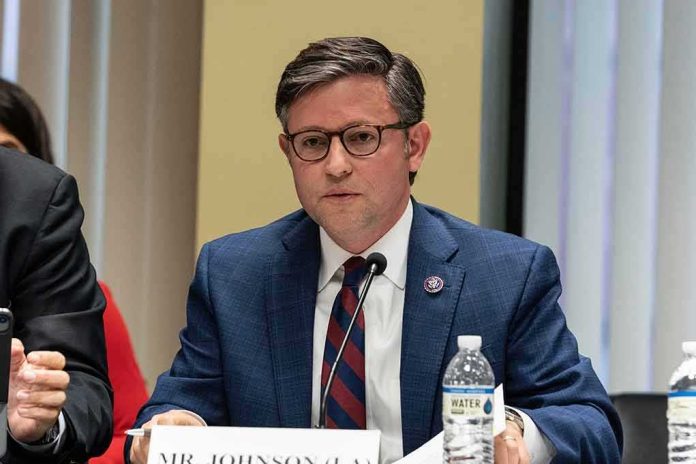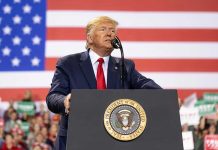
A single, heated encounter outside the House Speaker’s office exposed the raw nerves and procedural chaos rippling through Congress—revealing how a government shutdown transforms negotiations into a public battleground with very real consequences for representation and health care.
Story Snapshot
- On-camera clash between House Speaker Mike Johnson and Arizona Senators over government shutdown stakes
- Democrats raise concerns about health care funding and delayed swearing-in of a new Arizona congresswoman
- Confrontation highlights both deep policy divides and the human cost of political gridlock
- Public spectacle marks a new low in congressional dysfunction, fueling public distrust
Confrontation Erupts: Cameras Roll as Tempers Flare Outside Speaker’s Office
October 8, 2025, the marble corridors of Capitol Hill became the stage for a rare, unscripted drama. Senators Mark Kelly and Ruben Gallego, Arizona’s Democratic duo, emerged from Speaker Mike Johnson’s office visibly frustrated. Their concern: federal funding gridlock that left not only essential services in limbo, but also prevented a newly-elected Arizona congresswoman from taking the oath of office. As reporters crowded in, Speaker Johnson himself strode into the fray, and what followed was a tense, direct, and highly public exchange—each side laying blame for the shutdown and its cascading disruptions.
Words exchanged in that hallway underscored a hard truth: the shutdown was no longer just a matter of abstract fiscal priorities. The Arizona senators pressed the Speaker about the Republican spending bill’s impact on health care funding, and the fairness of leaving Arizona short a representative. Johnson, defending his party’s stance, countered with pointed questions about Democratic opposition to GOP proposals. The confrontation, captured in high-definition by news cameras, instantly became a symbol of a Congress at war with itself—and the consequences that flow from its stalemates.
Congressional Dysfunction: Gridlock with Immediate Human Cost
The government shutdown did not arrive out of nowhere. For months, House Republicans—led by Speaker Johnson—demanded spending cuts and policy changes, while Senate Democrats insisted on bipartisan solutions and warned of the real-world impact of slashing health care budgets. As negotiations dragged on, the shutdown’s effects multiplied: federal employees furloughed, contractors left unpaid, and services stalled. But the delay in swearing in Arizona’s new congresswoman turned a procedural hiccup into a constitutional concern, depriving an entire state’s constituents of full representation at a moment when every vote mattered.
Past shutdowns have featured similar blame games, but rarely have the consequences been so immediate and visible. The confrontation highlighted not just the depth of partisan mistrust, but the procedural fragility of Congress itself. With the cameras rolling, neither side could retreat to talking points. Johnson’s control over the House agenda clashed head-on with the Senate Democrats’ appeal for basic fairness and functional government. The human element—the Arizonans left without a voice—brought urgency and emotion to a debate often mired in abstractions.
Public Perception and the Erosion of Institutional Trust
The fallout from the confrontation spread far beyond Capitol Hill. Clips of the exchange circulated on news broadcasts and social media, fueling frustration among Americans already weary of government paralysis. For Arizona’s voters, the spectacle was doubly bitter: their new representative, elected to serve, was sidelined by a dispute that seemed more about political point-scoring than governance. Across the country, federal workers and contractors faced the uncertainty of missed paychecks and delayed projects, wondering how much longer they would be caught in the crossfire.
The problem is clearly the DEMOCRATS. Why? Because passing our clean CR to end the Democrat shutdown requires 60 VOTES in the Senate—and we have only 53 Republicans.
A bipartisan majority of the Senate supports the clean nonpartisan CR — and who is holding it up? Chuck Schumer… https://t.co/ZjePYrcgw1 pic.twitter.com/CzcxYaZFVe
— Speaker Mike Johnson (@SpeakerJohnson) October 8, 2025
Political analysts observed that such public confrontations are often used by leaders to rally their base and shift blame, but repeated shutdowns risk undermining the basic credibility of Congress. Academic voices warned that procedural breakdowns—like delayed swearing-in ceremonies—set dangerous precedents and threaten the continuity of democratic representation. Some saw the confrontation as an overdue moment of accountability; others, as a symptom of leadership failure and deepening dysfunction.
Shutdown’s Ripple Effects: Policy, Procedure, and the People Left Behind
Short-term disruptions—lost productivity, halted services, and delayed representation—are only the beginning. Over time, repeated shutdowns and headline-grabbing confrontations erode public trust, making it harder for Congress to function even after the cameras stop rolling. Health care providers worried about funding interruptions; businesses depending on federal contracts braced for uncertainty. For the broader public, the episode served as a reminder that partisan warfare in Washington does not just produce political theater—it has tangible consequences for everyday Americans.
As negotiations dragged on with no breakthrough in sight, the spectacle outside Speaker Johnson’s office stood as both a warning and a lesson. When political brinkmanship becomes the norm, and procedural rules become bargaining chips, the people Congress is meant to serve are the ones who pay the price. Whether this latest shutdown will prompt a reckoning or simply become another chapter in a cycle of dysfunction remains an open question—but one thing is clear: with cameras rolling, the cost of congressional gridlock has never been more exposed, or more personal.
Sources:
Senators press Mike Johnson to swear in Democrat who could force Epstein vote










